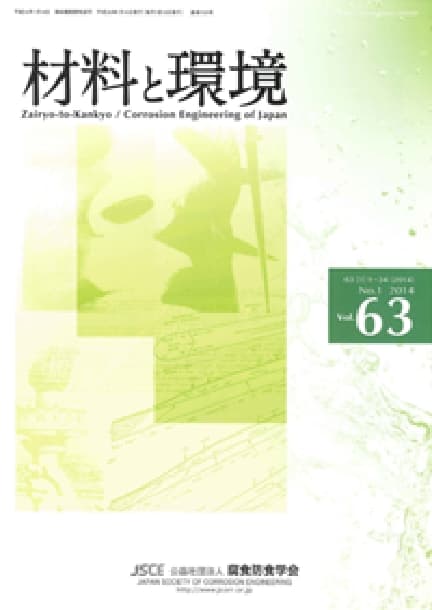- TOP
- Zairyo-to-Kankyo
- Vol. 69 (2020), No. 2
Zairyo-to-Kankyo Vol. 69 (2020), No. 2
Backnumber
-
Vol. 74 (2025)
-
Vol. 73 (2024)
-
Vol. 72 (2023)
-
Vol. 71 (2022)
-
Vol. 70 (2021)
-
Vol. 69 (2020)
-
Vol. 68 (2019)
-
Vol. 67 (2018)
-
Vol. 66 (2017)
-
Vol. 65 (2016)
-
Vol. 64 (2015)
-
Vol. 63 (2014)
-
Vol. 62 (2013)
-
Vol. 61 (2012)
-
Vol. 60 (2011)
-
Vol. 59 (2010)
-
Vol. 58 (2009)
-
Vol. 57 (2008)
-
Vol. 56 (2007)
-
Vol. 55 (2006)
-
Vol. 54 (2005)
-
Vol. 53 (2004)
-
Vol. 52 (2003)
-
Vol. 51 (2002)
-
Vol. 50 (2001)
-
Vol. 49 (2000)
-
Vol. 48 (1999)
-
Vol. 47 (1998)
-
Vol. 46 (1997)
-
Vol. 45 (1996)
-
Vol. 44 (1995)
-
Vol. 43 (1994)
-
Vol. 42 (1993)
-
Vol. 41 (1992)
-
Vol. 40 (1991)
Keyword Ranking
14 Dec. (Last 30 Days)
Zairyo-to-Kankyo Vol. 69 (2020), No. 2
The pH in Crevice Measured by a Semiconductor Chemical Sensor and Relationship with Crevice Corrosion Behavior of Stainless Steel
Kiyomi Nose, Haruhiko Kajimura, Ko-ichiro Miyamoto, Tatsuo Yoshinobu
pp. 40-48
DOI:
10.3323/jcorr.69.40Abstract
In order to clarify the relationship between crevice corrosion behavior of SUS304 and the pH in crevice(pHc), simultaneous measurement of pH in crevice by semiconductor chemical sensor at potentiostatic polarization.The pH measured by the sensor is not influenced by the metal ion and shows the value reflecting[ H+] and γH+.When crevice corrosion is always progressing by potentiostatic polarization, among the metal ions dissolved in the crevice, mainly in the hydrolysis reaction of Cr3+ or formation of chloride complex ions, the entire crevice part becomes extremely low pH environment with pHc<0.0.On the other hand, when polarization by two-step potentiostatic polarization, the amount of metal dissolved in the crevice decreases depending on the second potential(E2), and finally, eventually leading to re-passivation.In the case of this study, the re-passivation pH after crevice corrosion progression was 2.5 to 3, and the repassivation potential was about 80 mV, which gave high engineering significance.
The Effect Of Chloride Ion and Dissolved Oxygen Concentration On Passivation pH of SUS304 Stainless Steel
Akira Nagaoka, Ryo Matsuhashi, Kiyomi Nose, Kazumi Matsuoka, Haruhiko Kajimura
pp. 49-57
DOI:
10.3323/jcorr.69.49Abstract
When crevice corrosion of stainless steel occurs and progresses, the proton and the chloride ion concentration is high and there is no dissolved oxygen in the crevice. On the other hand, when crevice corrosion of stainless steel stops, the proton and the chloride ion diffuses out of the crevice and dissolved oxygen penetrates the inside of the crevice. In this case, the state of the stainless steel changes from active state to passive state.Since it is important to know the passivation behavior of the stainless steel, we invest the effect of chloride ion and dissolved oxygen concentration on passivation pH of SUS304 stainless steel.The passivation pH of SUS304 steel increased with increasing chloride ion concentration and decreasing dissolved oxygen. When cathodic current density exceeds ICRIT, passivation occurs.Therefore, It is assumed that the rise of ICRIT and the decrease of cathodic current density of the proton reduction with the rise of chloride ion concentration and the decrease of cathodic current density of the oxygen reduction with the decrease of dissolved oxygen concentration contributes to increasing passivation pH.
Article Access Ranking
14 Dec. (Last 30 Days)
-
Delayed Fracture Mechanism of 1700 MPa-Class Quenched and Tempered Bolt under Atmospheric Corrosion Environment
Tetsu-to-Hagané Advance Publication
-
Perspectives on the Promising Pathways to Zero Carbon Emissions in the Steel Industry toward 2050
ISIJ International Vol.65(2025), No.2
-
Effect of B on Surface Oxidation Behavior and Phosphatability of Si-Mn-added Cold-Rolled Steel Sheets
ISIJ International Advance Publication
-
Factors Influencing the Bonding Phase Structure of Iron Ore Sinters
ISIJ International Vol.43(2003), No.9
-
Effect of microstructural heterogeneity on fatigue limit of as-quenched low-carbon low-alloy martensitic steel
ISIJ International Advance Publication
-
Prussian blue as a fully reversible hydrogenochromic material for visualizing hydrogen distribution in Fe sheet
ISIJ International Advance Publication
-
Progress of Strip Casting Technology for Steel; Historical Developments
ISIJ International Vol.52(2012), No.12
-
Research Progress on Optimal Blending of Iron Ore Powders for Sintering
ISIJ International Vol.65(2025), No.12
-
-
Microstructures and Reduction Properties of High CaO Concentration Sintered Ore
ISIJ International Advance Publication
You can use this feature after you logged into the site.
Please click the button below.










